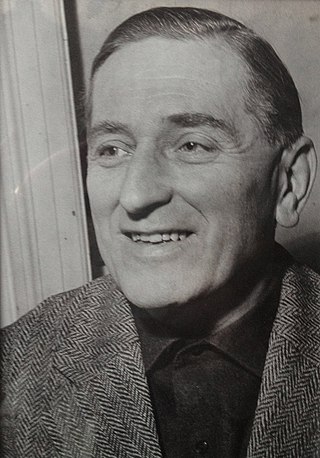Related Research Articles
Poul Kjærholm (1929–1980) was a Danish designer. Born in Østervrå, Denmark, Kjærholm began his career as a cabinetmaker's apprentice with Gronbech in 1948, attending the Danish School of Arts and Crafts in Copenhagen in 1952. In 1953, he married Hanne Kjærholm who became a successful architect. While working as a designer, he also became an educator continuing studies with Prof. Erik Herløw and Prof. Palle Suenson.

In architecture, functionalism is the principle that buildings should be designed based solely on their purpose and function. An international functionalist architecture movement emerged in the wake of World War I, as part of the wave of Modernism. Its ideas were largely inspired by a desire to build a new and better world for the people, as broadly and strongly expressed by the social and political movements of Europe after the extremely devastating world war. In this respect, functionalist architecture is often linked with the ideas of socialism and modern humanism.
Vilhelm Lauritzen was a leading Danish modern architect, founder of the still active architectural firm Vilhelm Lauritzen Arkitekter.

Kaare Klint was a Danish architect and furniture designer, known as the father of modern Danish furniture design. His style was epitomized by clean, pure lines, use of the best materials of his time and superb craftsmanship.
Knud Helmuth Holscher is a Danish architect and industrial designer. For many years he was a partner in KHR Architects with Svend Axelsson and designed many of their works together.

Christian Frederik Møller, generally referred to as C. F. Møller, was a Danish architect, professor and, from 1965 to 1969, the first rector of the Aarhus School of Architecture. His former practice, Arkitektfirmaet C. F. Møller, which he founded in 1924, still exists and bears his name. It is today the largest architectural firm in Denmark with branch offices in several countries.

Danish design is a style of functionalistic design and architecture that was developed in mid-20th century. Influenced by the German Bauhaus school, many Danish designers used the new industrial technologies, combined with ideas of simplicity and functionalism to design buildings, furniture and household objects, many of which have become iconic and are still in use and production. Prominent examples are the Egg chair, the PH lamps and the Sydney Opera House (Australia).

Danish modern also known as Scandinavian modern is a style of minimalist furniture and housewares from Denmark associated with the Danish design movement. In the 1920s, Kaare Klint embraced the principles of Bauhaus modernism in furniture design, creating clean, pure lines based on an understanding of classical furniture craftsmanship coupled with careful research into materials, proportions, and the requirements of the human body.
Gudmund Nyeland Brandt was a Danish landscape architect who was internationally renowned.
Fritz Hansen, also known as Republic of Fritz Hansen, is a Danish furniture design company. Designers who have worked for Fritz Hansen include Arne Jacobsen (1902–1971), Poul Kjærholm (1929–1980), Hans J. Wegner (1914–2007) and Piet Hein (1905–1996). Fritz Hansen also collaborates with contemporary furniture architects including Hiromichi Konno, Cecilie Manz, and Kasper Salto.
Vilhelm Wohlert was a Danish architect. His most notable work was on the Louisiana Museum of Modern Art in Humlebæk, Denmark.

Rødovre Town Hall is located at the centre of Rødovre, a municipality some 9 km (5 mi) to the west of Copenhagen's city centre. Completed in 1956, it was designed by the Danish architect Arne Jacobsen. A fine example of the international architecture trends of the 1950s, it was inspired by the General Motors Technical Center to the north of Detroit.

Søllerød Town Hall, now renamed Rudersdal Town Hall, was built for the former Søllerød Municipality which in 2007 became part of Rudersdal Municipality, combining Søllerød and Birkerød. The building is located in Holte some 19 km to the north of Copenhagen's city centre. Designed by Danish architects Arne Jacobsen and Flemming Lassen, it was completed in 1942.

Flemming Lassen was a Modernist Danish architect and designer, working within the idiom of the International Style. Among his most notable buildings are libraries and cultural centres. He was the brother of Mogens Lassen, also an architect.
Hanne Kjærholm was a Danish architect who also taught at the Danish Academy, where she became a professor in 1989.
Poul Ove Jensen is a Danish architect. He is the director of the bridge department at Dissing+Weitling. He was responsible for the design of over 200 bridges in 30 countries.
Niels Jacobsen was a Danish architect and politician who worked primarily in Odense. He was also the Chairman of The Lego Group until his death.
Palle Louis Nielsen was a Danish illustrator and graphic artist. Considered to be one of the masters of his times, his works include drawings, watercolours, woodcuts and linocuts.

Andreas Clemmensen was a Danish architect and royal building inspector.

Tyge Hvass was a Danish functionalist architect. He was most notable for his design work on the J.F. Willumsens Museum in Frederikssund.
References
- ↑ Engstroem, Laura (11 September 2021). "han-var-mentor-for-arne-jacobsen-og-poul-kjaerholm-nu-faar-en-af-1930-ernes-glemte-arkitekter-en-revival". Politiken.
- ↑ Dahl, Holger (11 September 2021). "byens-nye-luksushotel-er-sproedt-som-en-saltstang". Berlingske.
![]() Media related to Palle Suenson at Wikimedia Commons
Media related to Palle Suenson at Wikimedia Commons